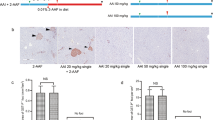Abstract
LIVER is not usually considered a target organ of hormonal factors known at present. Nevertheless, in certain animal species, the operation of such agents is clearly evident. Thus, liver cancer induction by certain carcinogenic azo dyes occurs more readily in female than in male mice. With certain other azo dyes1, and with 2-acetamidofluorene2 and its probable proximate agent N-hydroxy-2-acetamidonuorene3, male rats are considerably more susceptible than females. Liver carcinogenesis is enhanced by the joint administration of anabolic hormones, testosterone or cortisone, and 2-acetamidofluorene, its diacetyl derivative4 or its N-hydroxy derivative5. Castration of female rats and joint administration of testosterone and 2-diacetamidofluorene gave rise to liver tumours to almost the same extent as in male rats6. Whether these hormonal factors act directly or by way of alteration of the total hormonal balance involving the pituitary, gonads, adrenals and target organ is, at present, not known. Surgical removal of the adrenals or of the pituitary gland delays or abolishes carcinogenesis in the liver by azo dye or the carcinogenic fluorene derivatives (see ref. 7). Participation of hormonal factors derived from the pituitary in the carcinogenic process in the liver might therefore be surmised. However, direct evidence on this point has so far not been adduced. Bielschowsky8, Laws9, and also Glinos et al.10, have attempted to devise experiments to establish a multiple stage mechanism for liver carcinogenesis, but their observations were either negative or at best suggestive for the operation of such a process.
This is a preview of subscription content, access via your institution
Access options
Subscribe to this journal
Receive 51 print issues and online access
$199.00 per year
only $3.90 per issue
Buy this article
- Purchase on Springer Link
- Instant access to full article PDF
Prices may be subject to local taxes which are calculated during checkout
Similar content being viewed by others
References
Miller, J. A., and Miller, E. C., Adv. Cancer Res., 1, 339 (1953).
Sidransky, H., Wagner, B. P., and Morris, H. P., J. Nat. Cancer Inst., 26, 151 (1961).
Miller, E. C., Miller, J. A., and Hartmann, H. A., Cancer Res., 21, 815 (1961).
Firminger, H. I., and Reuber, M. D., J. Nat. Cancer Inst., 27, 559 (1961).
Yamamoto, R. S., Pai, S. R., and Weisburger, J. H. (unpublished work).
Morris, H. P., and Firminger, H. I., J. Nat. Cancer Inst., 16, 927 (1956).
Weisburger, J. H., and Weisburger, E. K., Clin. Pharm. Therap., 4, 110 (1963).
Bielschowsky, F., Acta Unio Contra Cancrum, 17, 121 (1961).
Laws, J. O., Brit. J. Cancer, 13, 669 (1959).
Glinos, A. D., Bucher, N. L. R., and Aub, J. C., J. Exp. Med., 93, 313 (1951).
Furth, J., Fed. Proc., 20, 865 (1961).
Bates, R. W., Milkovic, S., and Garrison, M. M., Endocrinol., 71, 943 (1962).
Bates, R. W. (personal communication).
Furth, J., Clifton, K. H., Gadsden, E. L., and Buffett, R. R., Cancer Res., 16, 608 (1956).
Rudali, G., Acta Unio contra Cancrum, 18, 190 (1962).
Cantarow, A., Paschkis, K. E., Stasney, J., and Rothenberg, M. S., Cancer Res., 6, 610 (1946).
Cohen, A. I., and Kim, U., Cancer Res., 23, 93 (1963).
Saffiotti, U., and Shubik, P., J. Nat. Cancer Inst. Monograph No. 10, 489 (1963).
Author information
Authors and Affiliations
Rights and permissions
About this article
Cite this article
PAI, S., YAMAMOTO, R. & WEISBURGER, J. Rapid Liver Tumour Induction by Concerted Action of N-Hydroxy-2-acetamidofluorene and Hormonal Stimulation. Nature 199, 1299–1300 (1963). https://doi.org/10.1038/1991299a0
Issue Date:
DOI: https://doi.org/10.1038/1991299a0
Comments
By submitting a comment you agree to abide by our Terms and Community Guidelines. If you find something abusive or that does not comply with our terms or guidelines please flag it as inappropriate.



